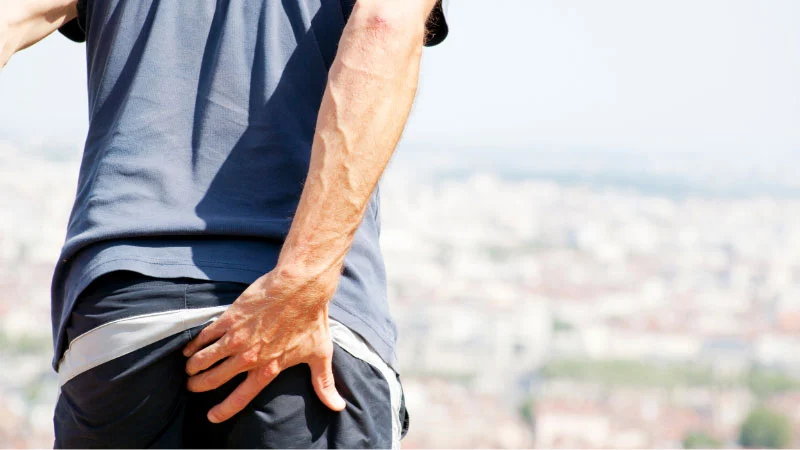Pilonidal disease, also known as a pilonidal cyst, is a condition that occurs in the area between the coccyx and the anus, usually as a result of infection and inflammation of hair follicles. It is most common in young adults and is more prevalent in males.

Causes of Pilonidal Disease:
Pilonidal disease is characterized by the infection and inflammation of hair follicles, particularly in the coccyx region. Various risk factors contribute to the development of pilonidal disease:
Hair Density and Structure: Individuals with dense and coarse hair are more likely to experience hair embedding under the skin and inflammation.
Gender: Males are at a higher risk of developing pilonidal disease, especially young and middle-aged men.
Age: It is more common in young adults in their 20s and 30s.
Obesity: Excess weight can increase pressure and friction in the coccyx region, raising the risk of pilonidal disease.
Prolonged Sitting: Sitting for extended periods, especially for certain professions (e.g., office workers, truck drivers), can create continuous pressure and friction, increasing the risk.
Lack of Active Lifestyle: A lack of physical activity can reduce blood circulation and increase the risk of pilonidal disease.
Personal Hygiene: Poor personal hygiene, especially due to sweating and dirt, can increase the risk of infection in the area.
Family History: Individuals with a family history of pilonidal disease are more likely to develop the condition.
Chronic Friction and Pressure: Continuous friction from clothes or wearing tight clothing can create pressure in the area, increasing the risk.
Symptoms of Pilonidal Disease:
Pain and Tenderness: Sharp or throbbing pain in the coccyx region, which can increase while sitting or applying pressure.
Redness and Swelling: The affected area can be red and swollen, feeling warm to the touch, indicating an infection.
Pus or Blood Discharge: When the cyst or abscess becomes infected, there can be a discharge of pus or blood, which may have a foul odor.
Small Holes or Channels Under the Skin: One or more small holes, known as pilonidal sinuses, can form under the skin, leaking pus.
Discomfort While Sitting or Walking: Swelling and pain in the area can make sitting or walking difficult and uncomfortable.
Hair Growth: Abnormal hair growth or hair embedding under the skin can be observed in the affected area.
Increased Temperature and Fever: In severe cases of infection, an increase in temperature in the area, along with fever and a general feeling of malaise, can occur.
How is Pilonidal Disease Treated?
Conservative Treatments: For mild cases, warm sitz baths, pain relievers, and good personal hygiene are recommended.
Antibiotic Therapy: If there is an infection, antibiotics may be prescribed by a doctor.
Surgical Drainage: If an abscess is present, surgical drainage under local anesthesia may be necessary.
Comprehensive Surgical Treatments: For chronic or recurrent cases, surgical interventions that involve the complete removal of pilonidal sinuses and cysts may be applied.
Laser Therapy: In some cases, laser therapy can be used as a minimally invasive option.
Post-Operative Care: After surgery, regular dressing changes and good personal hygiene are important to reduce the risk of infection and support healing.
What is Micro Sinusectomy?
Micro sinusectomy is a minimally invasive surgical method used especially in the treatment of pilonidal disease. This method involves the use of microsurgical techniques to remove the sinus channels causing the pilonidal disease and the surrounding inflamed tissue. The goal is to clean the diseased area with minimal damage to the surrounding tissue and ensure a quick recovery process.
How is Micro Sinusectomy Performed?
- Performed Under Local Anesthesia: Patients are usually treated under local anesthesia, which provides painlessness during the procedure.
- Minimal Incisions: The surgeon uses microscopic tools to remove the pilonidal sinuses and affected tissue through very small incisions.
- Tissue Removal: The diseased tissue is carefully removed while minimizing damage to healthy tissue.
- Drainage: If necessary, a temporary drainage tube may be placed in the area to accelerate healing post-surgery and reduce the risk of infection.
- Quick Recovery Process: Micro sinusectomy offers advantages over traditional surgical methods, including less pain, shorter recovery time, and lower recurrence rates.
Advantages:
- Reduced Pain and Discomfort: Smaller incisions reduce post-operative pain and discomfort.
- Short Recovery Time: Patients typically experience a quicker recovery process following the operation.
–